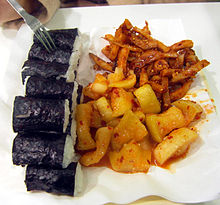Gimbap
| Gimbap | |
 Platter of sliced gimbap | |
| Korean name | |
|---|---|
| Hangul | 김밥 |
| Revised Romanization | gimbap |
| McCune–Reischauer | kimbap |
Gimbap or kimbap is a popular Korean dish[1] made from steamed white rice (bap) and various other ingredients, rolled in gim (sheets of dried laver seaweed) and served in bite-size slices.[2] Gimbap is often eaten during picnics or outdoor events, or as a light lunch, served with danmuji or kimchi.[3]
Ingredients
The basic components of gimbap are rice, meat or other protein-rich ingredients, and a large variety of vegetables, pickled, roasted, or fresh. Traditionally, the rice is lightly seasoned with salt and sesame oil/perilla oil. Popular protein ingredients are fish cakes, crab meat, eggs, and/or seasoned beef rib-eye. Vegetables usually include cucumbers, spinach, carrots, and danmuji (pickled radish). After the gimbap has been rolled and sliced, it is typically served with danmuji.


Varieties
Short grain white rice is usually used, although short-grain brown rice, like olive oil on gim, is now becoming more widespread among the health-conscious. Rarely, sweet rice is mixed in gimbap rice. Nowadays, kimbap's rice is many kind of black rice, boiled rice and cereals etc.
Gim is dried, pressed seaweed made from the edible species, laver. Gim may be roasted and seasoned with oil and salt, roasted but unseasoned, or raw and unseasoned. The oil used for roasting gim is traditionally sesame oil; however, today, corn and canola oils are also commonly used, especially with the pre-seasoned packs of gim sold widely in stores. Olive oil is also becoming more prevalent. For gimbap, the roasted, unseasoned variation is typically used.
Besides the common ingredients listed above, some varieties may include cheese, spicy cooked squid, kimchi, luncheon meat, or spicy tuna. The gim may be brushed with sesame oil or sprinkled with sesame seeds. In a variation, sliced pieces of gimbap may be lightly fried with egg coating.[2]
Samgak gimbap (삼각김밥) is a triangle-shaped gimbap sold in many convenience stores in South Korea. It is derived from Japanese triangle-shaped rice ball "Onigiri" which was introduced in Japanese convenience stores in South Korea in recent years. Samgak gimbap also come in many varieties.[4]
'Chungmu gimbap is an unique gimbap made without any ingredients inside the roll. Originating from the seaside city of Chungmu, the rolls are thinner than regular gimbap and the surface is not brushed with sesame oil. Chungmu gimbap is tradtionally served with side dishes of kolddugi muchim (꼴뚜기 무침), sliced baby octupus marinated and fermented in a spicy red pepper sauce, and radish kimchi (무김치).[5]
International familiarity
Gimbap was selected the top 100 foods of Korea for foreigners.[6] Canada's largest urban weekly, straight.com spotlighted gimbap in an article comparing it with sushi entitled Korean kimbap rolls out of sushi's shadow.[7] The article ends with this comment: "No need for soy sauce, wasabi, or pickled ginger: kimbap stands alone. It's a star waiting to be discovered."
Franchise

Many South Korean fast food restaurant franchises specialize in gimbap and noodles, and these establishments are extremely diverse in the cuisine they offer. Such chains include Gimbap Heaven (김밥천국), Gimbap Land (김밥나라), Gimgane (김家네), Gimbap and Spaghetti (김밥과 스파게티), Gimbap Nara (김밥나라) and so on. These restaurants serve not only gimbap but also numerous other dishes, ranging from small snacks to pork cutlets, ramyeon, bibimbap, and other dishes.[8]
References
- ^ Kimbap, excerpt from Andrew J. Luxner's American English: A Teachers's Journey in Seoul, South Korea. Golden Hill Books, San Diego. ISBN 0-9760748-1-8
- ^ a b Template:Ko Gimbap at Doosan Encyclopedia
- ^ Template:Ko Gimbap at Encyclopedia of Korean Culture
- ^ Template:Ko Popularity of samgak gimbap, The Financial News, 2008-11-24. Retrieved 2010-06-25.
- ^ Template:Ko Chungmu gimbap at Doosan Encyclopedia
- ^ Template:Ko icon "우리나라를 대표하는 음식 100가지" Yonhap News, 2007-12-03.
- ^ Carolyn Ali "Korean kimbap rolls out of sushi's shadow", Straight.com, June 7, 2007.
- ^ Template:Ko Gimbap franchises popular, Edaily EFN, 2008-09-04. Retrieved 2010-06-25.
See also
External links
- Gimbap recipe at Chow Times
- Template:Ko Tuna gimbap recipe at Naver Kitchen
